Festival Avant-Garten
(2017)
The following text was written for the publication “notes and dramaturgy about processes in the life arts: Spain and Uruguay” edited by El Centro Cultural de España (CCE) and Casa Editorial HUM / Estuario en el marco del Plan Editorial 2019 de la Agencia Española de Cooperación Internacional para el Desarrollo (AECID). Compiler: Xurxo Ponce. Translation: Michael Lomax.
We have used the proposal to participate in this publication to undertake a memory exercise on a project that came out of the commission for the Theater der Welt Festival 2017, which I received from András Siebold, Artistic Director of the Internationales Sommerfestival in Kampnagel-Hamburg.
We believe that this review can serve as a guide to the thinking that underpinned the entire project. The initial intentions and final decisions can give an idea of how we activated a public space and turned it into a lively, dynamic, critical and accessible place.
The initial commission consisted of a specific site in the Hafencity – an urban residential area newly built in the Hamburg port area that had served to rehabilitate the entire zone, generating a new neighbourhood for people with high purchasing power.
To conceptualize and develop the entire project, I invited artist Arantxa Martínez.
The project ultimately failed to gain the support of the other co-curators of the Theater der Welt Festival, and András Siebold resituated it in his programming for the Internationales Sommerfestival. In this new context, he commissioned us to activate the festival garden during the three weeks of its existence in collaboration with the Studio für Experimentelles Design der HFBK (Studio for Experimental Design of the Hamburg School of Fine Arts), directed by Professor Jesko Feser, and his students: Helena Kersting, Anna Petersen, Felix Egle, Kolja Vennewald, Liez Müller, Liza Beutler, Luisa Hilmer and Tatjana Schwab.
This garden is known as one of the meeting points during the festival. It is situated in a parking lot to the rear of the Kampnagel, organized around an area with trees and irregular vegetation and next to one of Hamburg’s many canals.
During the year this rear area operates as a parking and loading and unloading area for the different Kampnagel theatres and spaces, as well as a passage giving access to other residential zones in the area and to different public areas around the canal. During the festival the garden is converted, from one edition to the next, hosting different projects and always functioning as a space in which festival spectators and visitors can access the information point, grab something to eat in the restaurant bar and food carts, use the various temporary sanitary facilities and be in a pleasant environment in which to sit and have a good time.
Normally the parking floor is covered with dark brown wood shavings, hiding the asphalt, giving the feeling of being in a small forest.
Being relocated in this space forced us to rethink almost the entire project. The garden had a pre-determined dynamic (summer festival garden with all the attendant expectations), unlike in the Hafencity port area, where at that time the various urban functions had not yet been fully activated as people were only beginning to move into it.
We adopted the name Avant-Garten Festival as had been done in other editions since 2014, when Nadine Jessen carried out her project consisting of “an ecofeminist garden that combined the practice of magical gardening and geomancy with the aim of re-cultivating local psychoactive plants (such as mandrake, woodruff, fungi). They also practised and developed their ‘botanical voguing’ skills there.”
As our project failed to take place in the residential port area, we are not going to explain in this text the initial ideas, but we do want to touch upon the urban spirit and some particular features of the public space that came out of that project and that ultimately provided a very particular texture to everything we ended up doing in adapting it to the Festival Garden, producing timing and spatial consequences at a perceptual level.
The urban spirit was connected with the sensation of being open to the elements, in the middle of a complex network of interests, in which you have to find a way to access and inhabit the space. We were keen to contradict the exclusivity to which the festival garden could be linked, not only by its ‘backyard’ location but by the snobbery with which culture continues to flirt.
The urban aspect sought to break open the imaginary protective fence between that place and the rest of the city. Everyone could pass through. The festival and culture were not represented as a way of distancing oneself from reality. On the contrary, this garden sought to shelter and even protect the uncertainty of the urban space where planned order yields to uncontrolled life. It was about creating reality in real time.
In terms of time and timing, we wanted to propose a certain lack of control to produce an acceleration. The unexpected always comes in an immediate format.
Paradoxically, this garden also had to offer a dilated sense of time, inviting people to spend time in it and even lose their sense of time. It had to serve as a refuge but combining the idea of protection with that of exposure. It had to intensify the public, open, available, participatory and convivial aspect, with visitors identifying the garden with practices extending beyond its most basic functions of information, hospitality and sanitation.
All the projects that we presented and on which we worked throughout the festival posed questions that encouraged us to think and invent what practices, gestures and ways could activate or interrogate what we understand as “public” in the visitor’s experience.
How could we suggest to everyone that what was there had the potential to be transformed, and that they were invited to stay and participate in the micro or macro events if they remained long enough.
This space that we reclaimed as public wanted to offer itself as a place that at once welcomes you and questions you. A place where we can think together, have fun together, be amazed together, spend time together. A place that, although appearing as a “portion” of the summer festival, was concerned to include the possibility of a greater reality. It was all about creating community.
Collaborating with the students who designed the architecture of the garden space and who proposed a political gesture of anti-festivalization, we agreed on the desire to break not only at a symbolic level but also at a practical level with the dynamics of festivalization and consumption that take hold of these spaces, even if this was not proposed by the festival itself. Some festivals make the critical space invisible, turning it into a consumption space where the important thing is to feel at ease and empathize with the environment and, above all, with zero difficulties.
The students proposed a space that would not try to hide the parking area function it has during the rest of the year (no wood chips this year, asphalt, trees and greenery living together). They also built seating areas, a mound of grass and mirror walls that reflected visitors and concealed the main facilities of the garden (information point, bar and toilets). In this way, on arriving there all you saw was an empty space, but one that spoke. It was not a neutral space, not did it guide or facilitate, but it proposed presence and mobilization. The space was to be interpreted and activated by the visitors, the space was offered but not given to you, you had to take it.
In the process of creation, we were developing our project at the same time as the students, so we contaminated each other, ideologically and practically. There were problems like generating more space where people could feel the desire to stay. It was not about making a declaration of principles in which our critical spirit was clear but could not be applied. It was about transforming a space and its habitual dynamics to make people gain more agency than usual, in terms of thought and action.
We wanted to activate that space, for it to provoke questions by the very fact of entering it, turning it into a place in motion, of constantly changing dynamics.
How did we think we would change the dynamics?
Interfering in what was going to happen there. We wanted it not to be a place of expectation, we didn’t announce anything in the programme except that we would be there throughout the festival accompanied by different guest artists. We used the different flows of the garden and we sneaked into visitors’ time, generating a variety of activities and proposals of different kinds (practices taking place throughout the festival, author concerts, outdoor films, bonfire conferences, readings, different forms of writing, raves, mini bar and mini club in the trunk of a car).
In a way it was a festival within the festival. The difference was that our Avant-Garten was semi-hidden. Never knowing what was going to happen there, the visitor could be lucky or not to run into one of the proposed activities. We worked with the reverse of what normally happens at a festival, seeing in a programme what will happen and picking out what interests you. In Avant-Garten we worked in the same way as musicians playing in the subway, who enter the cars, sing and leave. There was a tension between what was decided and imposed by us and the feelings of invasion and acceptance of what was happening there by the visitor. It was important not to forget that the space belonged to everyone and was for everyone. This was very interesting in the ways visitors reacted. Each decided the level of involvement and attention with which they wished to relate to what was going on there. The value of what was presented was questioned without claiming it. Not being in the programme and in the garden, there were people who took it as entertainment or as background to what they were doing at the time, while others entered directly into what was going on. Also the degree of attention not only changed the value of things but also their nature. Recognizing something is not the same as passing through it: we proposed time and space to experience the place.
All our activities were free of charge, another aspect that questioned the value that could be given to the projects we presented. The economy produces value without necessarily paying attention to what is being proposed, and this generates customs and dynamics.
For us it was important to reclaim the public space that in our case was both semi-public and semi-private (open to any visitor, even to those not coming to the festival, and at the same time belonging to a festival and an institution).
Public space as a type of oasis serving as a refuge, a truce and a mirage. A refuge because we wanted it to be a real space, in relationship and emancipated from consumer dynamics, a space to recharge the batteries. As a truce that proposes a halt in systematic time frames in which there is no room for spontaneity, improvisation or surprise. And as a mirage to be able to imagine, dream and discover the other that is possible but not named.
Our proposal was to invite a number of artists to inhabit the garden with their projects and to enter into some of the artistic practices that we developed throughout the festival.
In this way we generated a kind of tribal family living in that garden and doing things every day. To this family were added all kinds of people who came every day, as if it were their neighbourhood, their home. This quickly turned into a dynamic. Repeat visitors knew that there would be different things happening there at different times. This aspect had a negative side in that, at times, what was going on could go unnoticed by many people. We wanted the project to grow, develop and transform as the festival progressed through time. We were constantly rethinking tactics to give our proposals greater value for visitors. And to re-negotiate a space that would become a place to practice and experience different realities. We used different tactics to communicate, from the total surprise of a proposal that suddenly began by surprise, to leaflets giving a programme of artists without schedules, or time slots announced in which something would happen, to personally inviting everyone in the garden to what was going to happen in 15 minutes’ time.
These ways of communicating implied a certain contradiction, but provoked dynamics that interested us. What happened there was non-negotiable, as if it were an act of nature; but with the freedom to decide, we had a certain agency over all acts.

We now proceed to summarize what happened in Avant-Garten 2019.
LIVING SCULPTURES
Taking the typical sculptural form of parks and gardens, we developed the idea of living sculptures that would occupy the garden temporarily for two hours a day, coinciding with the times when a greater influx of people could be expected in the garden based on the festival programme, its schedules and the times between shows.
Throughout the three weeks of the festival, the contribution of our presences as living sculptures responded to a progression and transformation of the formal content , while maintaining the parameter of nudity as an essential motif on which to create variations. Nudity was the way to minimize the possible distance between our presences and their representational or symbolic potential. Nudity made it possible to say something elementary without words: what is visible is what you can see and what you see now is nothing more than what you see. It was also a way of turning over to the visitor the responsibility of creating speech. The body was presented explicitly and this literalness was intensified with the themes that traversed the sculptural proposal.
By stopping the logical movement of everyday actions there is a commentary, they talk to you without doing so, they talk to you about the body we all have and hide. They free themselves from prejudices to comment on yours or, in the simplest of cases, they propose to you to see yourself, recognize yourself, mirror effect and proposing a space and time to be together.
The bodies presented themselves in the first place in twos or three. Adopting everyday postures, they challenged the visitor as they could look you in the eye and were in the same position as you when looking at them.
Later we approached some positions that suggested sexual pleasure. These more sexual positions were presented explicitly and we could each choose the positions with which to work from a bank of about 30 positions that Arantxa and I had previously developed. These postures were bodies interwoven in different ways and with different muscle tone. From resting positions to semi-erect bodies that grabbed parts of the other body or allowed themselves to be grabbed, that showed more or less the sexual organs, that involved looking or which abandoned themselves, closing the eyes or covering the face.
The sculptures functioned as a mirror where the reflected bodies had been emancipated from the real bodies, those of the visitor, taking the license to enjoy each other sexually, semi-hidden among the hedges.
The sculptures left the central position of the statue-as-monument and went to the periphery, to semi-visible areas in exchange for gaining agency to do what they wanted. The same idea inside a museum or theatre would have produced something very different. A naked body inside the theatre means certain things, within the safe space, the space specific to representation. A stone sculpture in the garden means other things and proposes a different way of relating. Our living sculptures were between the two sites, neither inside nor of stone.
These sculptures, being alive and not having a fixed schedule, first became a spontaneous background for visitors, a texture of the place. They could become a figure depending on the type of attention they were given. We wanted the environment and context, which at times absorbed everything that happened there, to interfere .
The sculptures did not produce expectation, they appeared suddenly without you noticing, they entered more into the subconscious. It was interesting to see how visitors tried to make the presence of these sculptures seem natural. It was as if despite being alive, breathing, moving minimally or moving around the space to change positions, some visitors wanted to freeze them, turn them into stone sculptures. Children, on the other hand, tried to play with them, some adults took pictures, or insisted on looking profoundly and for a longer time. The viewer had agency to produce one or the other experience with the sculptures depending on the time spent with them observing them, building what you could see and what you projected with them.
The tensions created differed depending on the observers’ intentions.
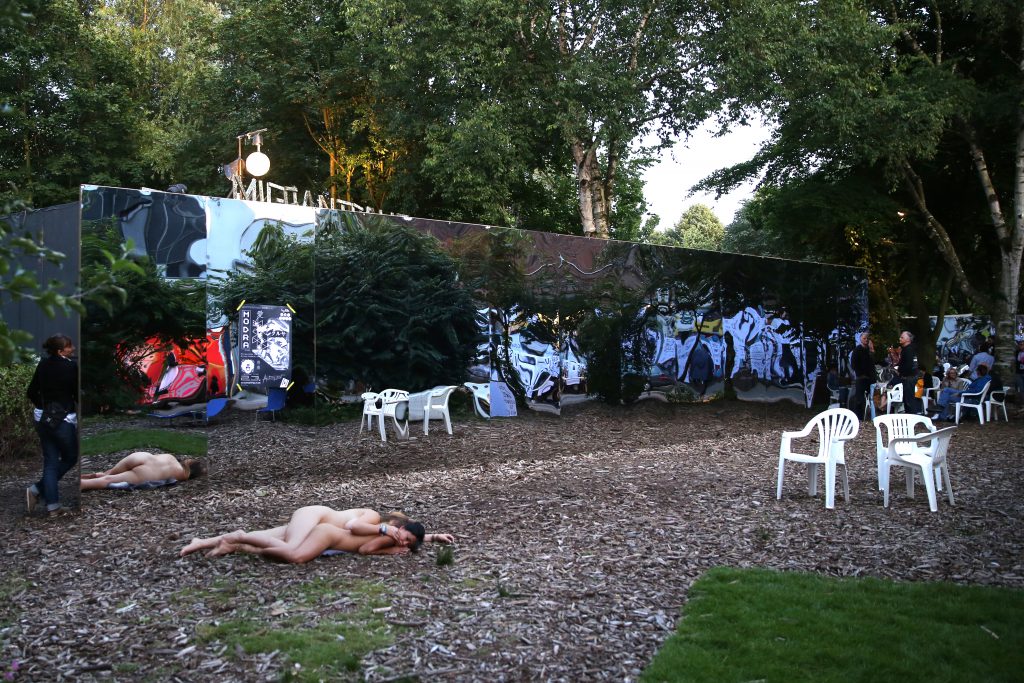
We were not looking for the plastic and aesthetic dimension generated to produce a friction contrary to the poetic gesture that this type of sculpture could create. But we did want to generate a tension that spoke of the body in the most essential sense. We were interested in the idea of de-culpabilizing the fact of having a body. We found the discomfort with which many visitors had to negotiate upon encountering the sculptures very interesting.
Also with the sculptures we generated a certain eroticization of the place we were interested in, a certain sexualization. The place had a different tone when the sculptures were there.
Living sculptures produced reality rather than representation. They generated reality as the first filter and then questions since they did not pretend to be public ornamentation.
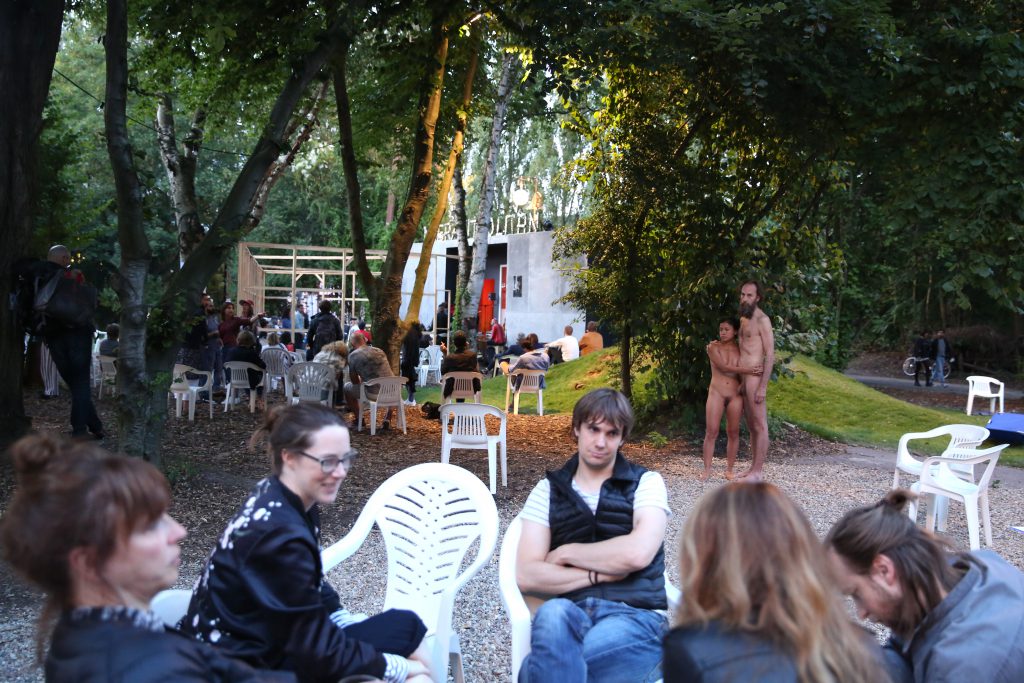
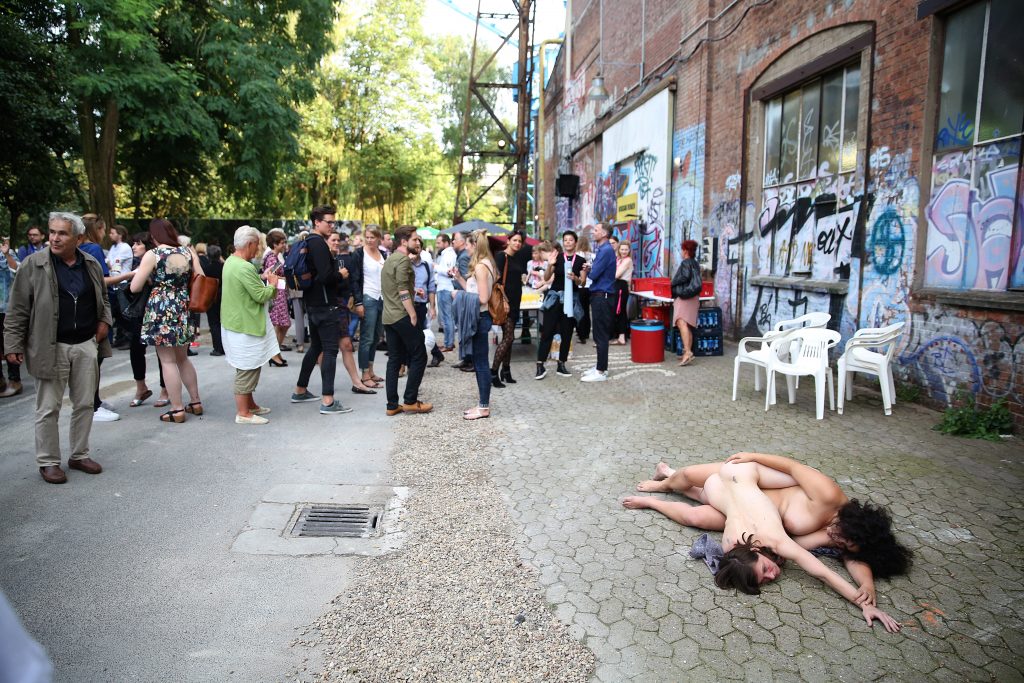
Living sculptures: Maria Yolanda Morales, Jelena Gerrard, Michael Del, Serfiraz Vural, Milena Kann, Anne Marie Kersten, Laura Ehrich, Britta Huntemann, Michael del Coco, Xing Cheng, Doris Defeyter, Arantxa Martínez and Juan Domínguez.
SLOGANS
Little by little we created with the sculptures a relationship with another practice that we developed in the garden, each serving as background and figures to the other.
This practice, that of posters, was influenced by street graphics, not so much author graffiti, but rather urban graffiti (mostly anonymous and illegal) and the sensations created by certain slogans normally seen in large cities. One of our favourite examples was the one we saw in a garbage container where it was written: “Why isn’t it burning?”. It is incredible that such a short phrase can generate so many relationships.
So we developed a practice in which we created black-and-white posters with phrases that worked like slogans.
The posters only included phrases with a manual typeface, generating a more analogical idea of spontaneity that helped us express greater urgency and create more provocation with the messages.
These messages were addressed to everyone passing by, whether coming to the festival or not.
Normally the spaces that are chosen for these types of expression are walls of buildings, park benches, tunnels, stairs, subway and trains, objects. Our practice expanded not only in time but in space. The posters accumulated daily and began to occupy different places even outside the garden, where festival spectators and visitors, local suppliers and workers and citizens passing through could see and read them at all hours.
Starting from some initial phrases, we worked every week with guest artists, generating new posters and incorporating their ideas and interests.
We worked with three kinds of messages, always brief:
– Some were aimed at the visitor directly and forcefully, with ethical and political appeals. The intention was for the reader to place this type of message in his personal imagery when reading it, and appropriate or reject it.
– The second type involved more ambiguous phrases generating more cognitive and emotional relationships.
– And with the third type we proposed parts of the body that physicalized the place and even eroticized it.
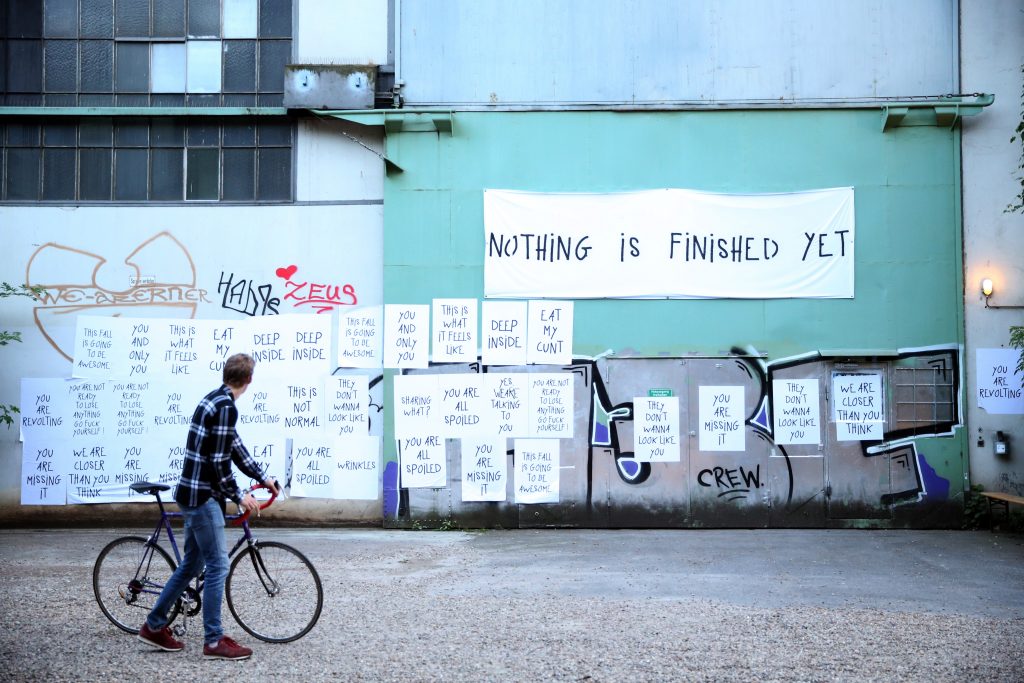
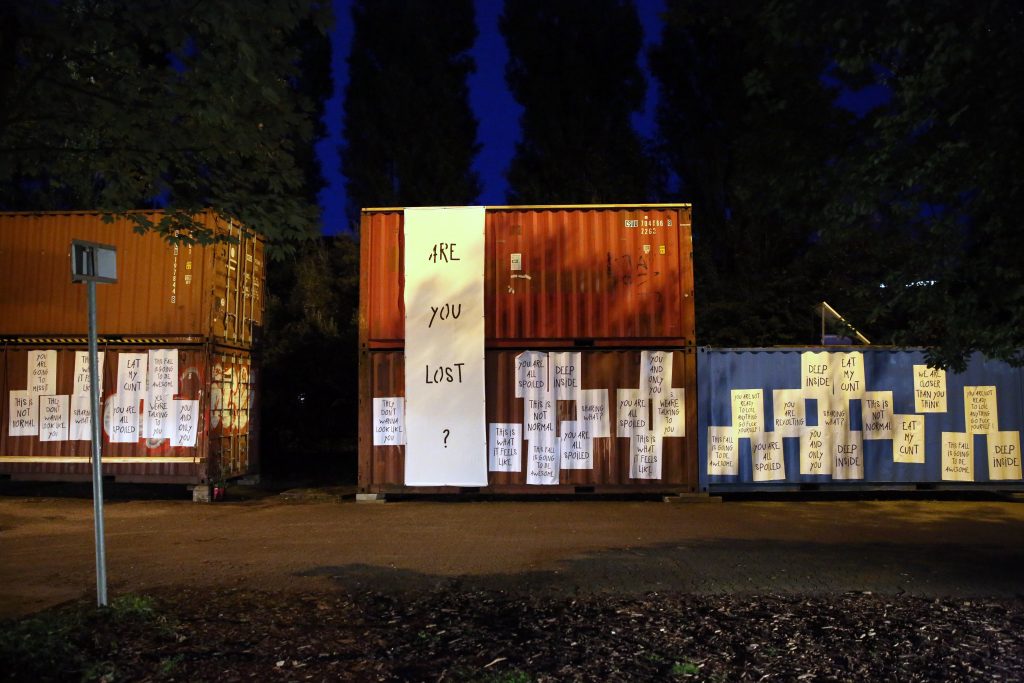
Slogans made in collaboration with María Jerez, Valeria Graziano, Giullia Palladini and Mette Edvardsen.
CAR BAR
The Car Bar, an idea that we took and reinterpreted from the Valencia festival and what the car meant at that time for the young people: opening the trunk, putting on music, drinking, dancing on top of the cars… meeting others, etc… as a form of appropriation of the public space, had an irregular timetable. You never knew when it would open or when it closed. Basically it was about offering a bar service with cheap beers from the trunk of the car, which is where the music came from and about spending time with the Avant-Garten artists. The car changed places every day, always inside the garden.
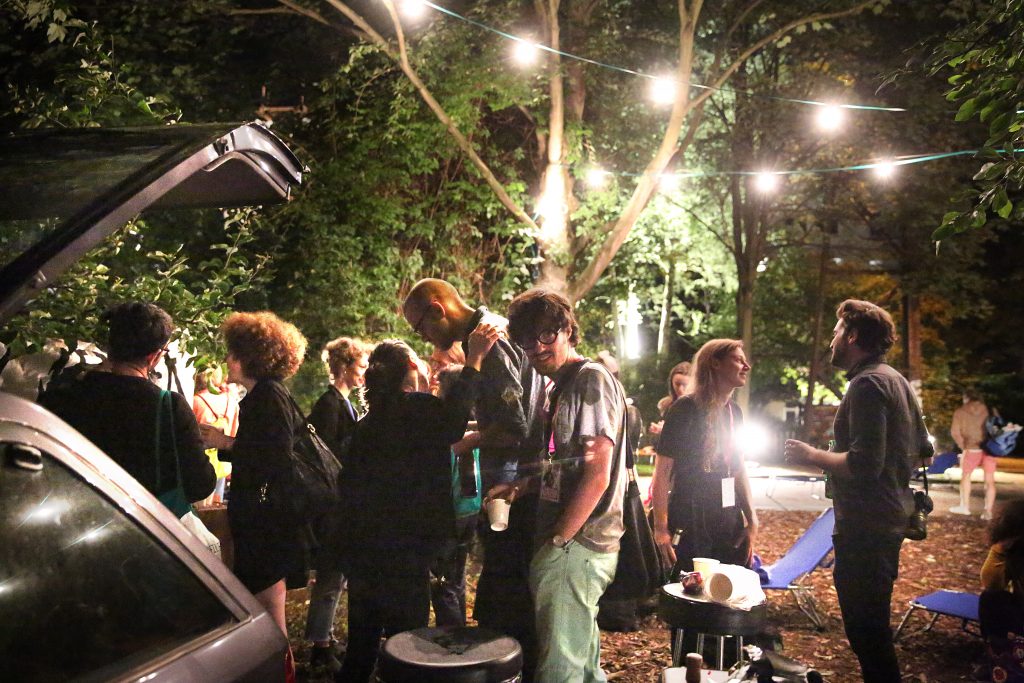
Playlists made by artists Sara Manente and Julia Rodriguez.
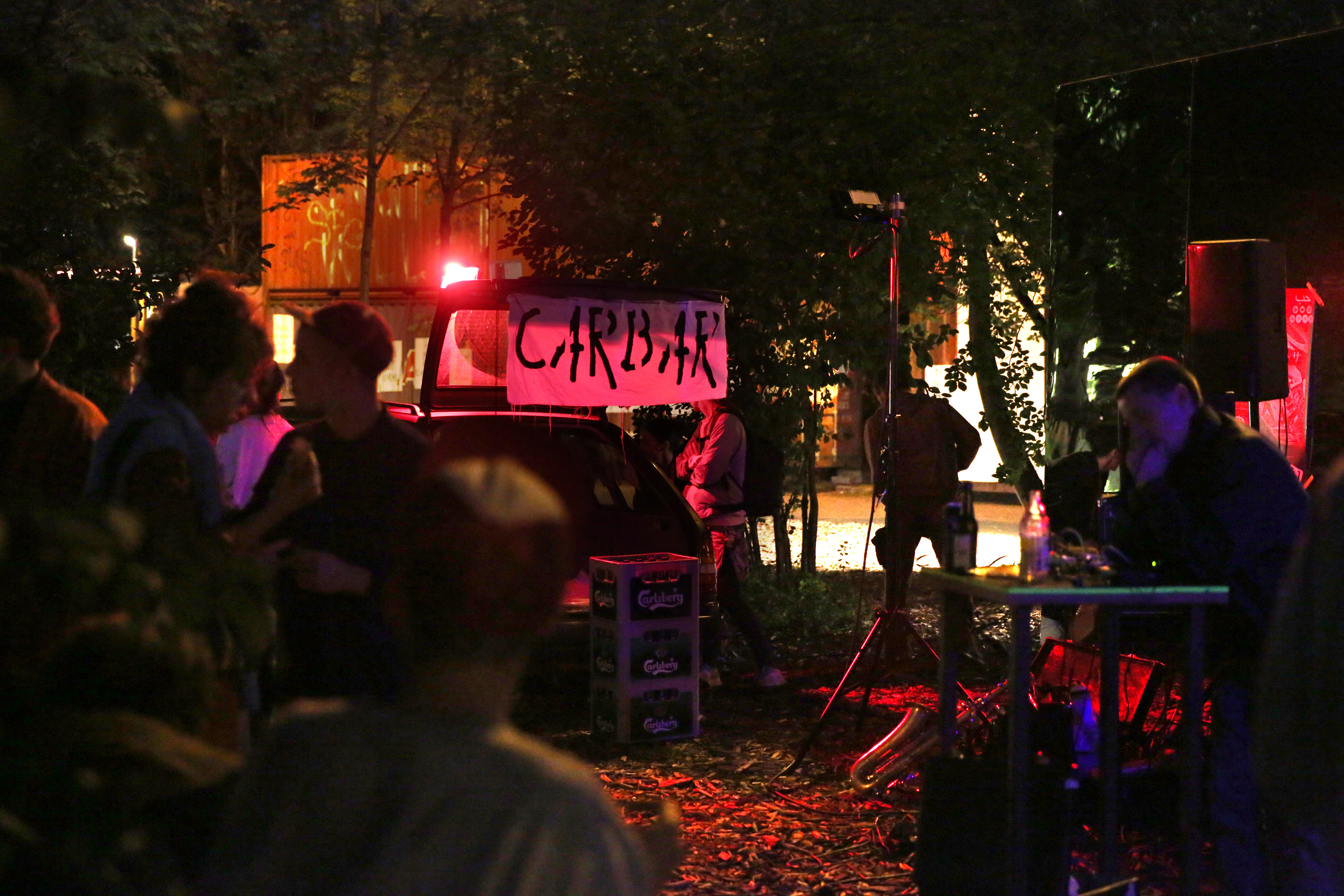
DISTINGUISHED LIBRARY
This was a table offering a selection of 19 books proposed by some of the artists taking part in the Avant-Garden Festival. The person in charge of this select library proposed to visitors to borrow a book and walk around for an hour with it before returning it.
The 19 books consisted of contemporary narrative, thought and criticism. The intention was for people to enjoy the parts of the books suggested by the artists as they roamed freely through an area adjacent to Kampnagel.
“Choose a book and start walking with it. When you feel it’s time, start reading. Without any pressure, read comfortably, take your time. Come back to this point when you’ve finished. Return the book and you’ll recover the identity document you handed over. It’s all about reading in movement and moving one’s reading.”
List of books: For More Than One Voice: Toward a Philosophy of Vocal Expression by Adriana Cavarero / Sister Outsider: Essays and Speeches by Audre Lorde / Six Memos for the Next Millennium by Italo Calvino / The Walk by Robert Walser / Walden; or, Life in the Woods and Walking by Henry David Thoreau / Society of the Spectacle by Guy Debord / The Festivalisierung der Stadtpolitik – Stadtentwicklung durch große Projekte by Walter Siebel / One Way Street by Walter Benjamin / Alphabet by Inger Christensen / The Lesbian Body by Monique Wittig / The annotated Alice in Wonderland commented by Martin Gardner / Notes toward a performative theory of assembly by Judith Butler / Wanderlust: A history of walking by Rebecca Solnit / Junkspace by Rem Koolhaas / The weird and the eerie by Mark Fisher / The Problem with Work: Feminism, Marxism, Antiwork Politics, and Postwork Imaginaries by Kathi Weeks / Degrowth: A vocabulary for a new era by Giacomo D’Alisa, Federico Demaria and Giorgos Kallis / To Our Friends by The Invisible Committee / Capitalism in the Web of Life: Ecology and the Accumulation of Capital by Jason W. Moore.
Books proposed by Valeria Graziano, Giullia Palladini, Mette Edvardsen, María Jerez, Arantxa Martínez and the Experimental Design Studio of the Hamburg School of Fine Arts.
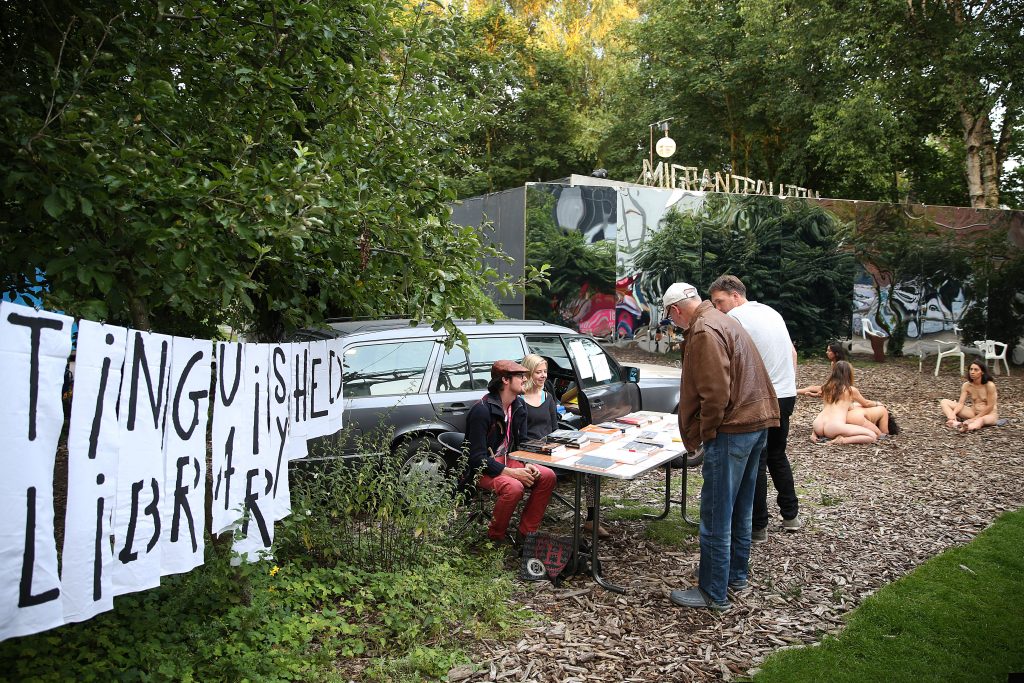
PROGRAM (PM-AM Garten)
PM-AM Garten consisted of semi-invisible programming in two time slots; from 18:00 to 24:00 and from 24:00 onwards, in which the guest creators embarked on a semi-anonymous relationship by not notifying what was going to be presented or at what time.
Programme:
Friday 11th August 2017
21:15 ZEA Arnold de Boer (concert) zeamusic.bandcamp.com
24:00 Donna Haraway: Story Telling for Earthly Survival by Fabrizio Terranova (film) 2016
Saturday 12th August 2017
24:00 Alma de Rímel & The Glammatics by María Jerez (concert)
Sunday 13th August 2017
19:00–21:00 Erotic Poetry by Jariu Niesner (writing situation)
Friday 18th August 2017
24:00 Valeria Graziano and Giulia Paladini (bonfire conference)
Saturday 19th August 2017
24:00 Très bien éclairé by Arantxa Martínez (performance)
Sunday 20th August 2017
19:00–21:00 Erotic Poetry by Jariu Niesner (writing situation)
Wednesday 23rd August 2017
22:00 Dabeler Differently Sexy by Gereon Klug and Reverend Christian (performative conference)
Thursday 24th August 2017
18:00–20:00 Car Parade with DJ Kris
Friday 25th August 2017
22:00 Nunca llevo falda porque no se cruzar las piernas by Angela Milano (performance)
24:00 Heart of a Dog by Laurie Anderson (2015 film)
Saturday 26th August 2017
21:00 Wave Sound by Sonia Noya (environmental concert)
24:00 No Title by Mette Edvardsen (performance)
Festival Avant-Garten 2017 was a project by Juan Domínguez and Arantxa Martínez in collaboration with the Experimental Design Studio of the Hamburg School of Fine Arts headed by Professor Jesko Feser. Students: Helena Kersting, Anna Petersen, Felix Egle, Kolja Vennewald, Liez Müller, Liza Beutler, Luisa Hilmer, Tatjana Schwab. Commissioned by Internationales SommerFestival 2017 (Kampnagel-Hamburg).
